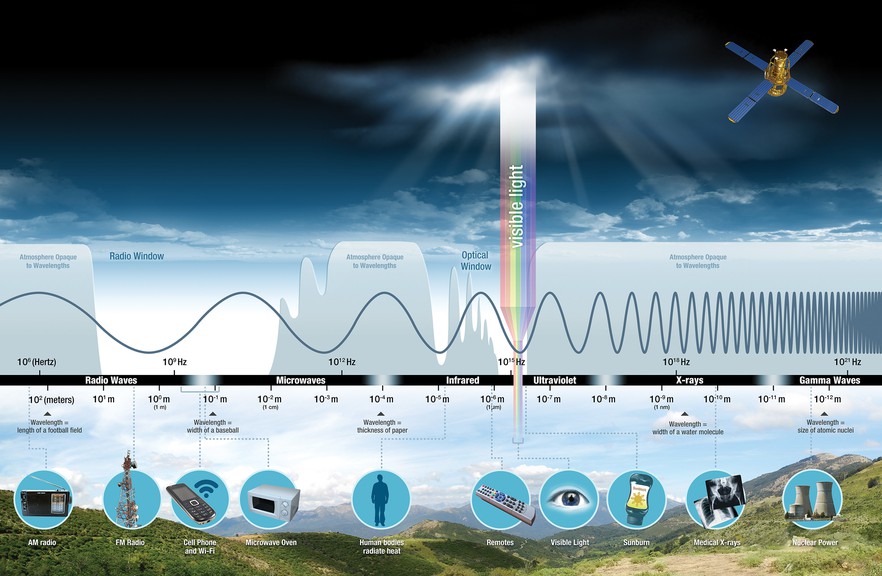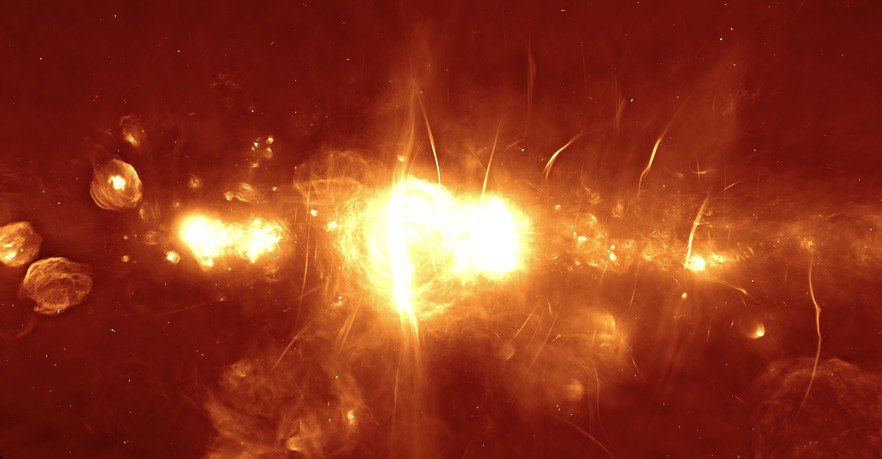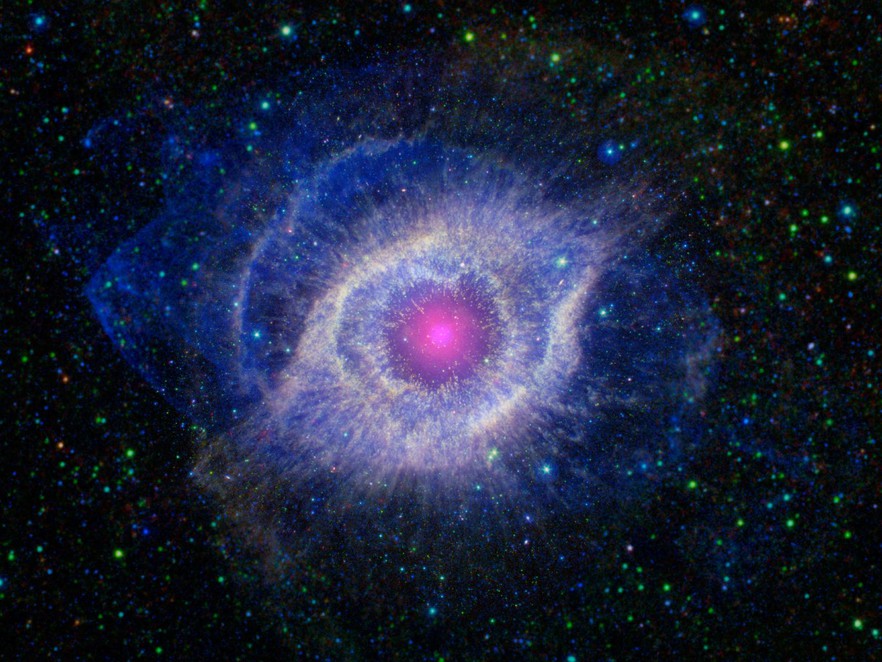Why we need the James Webb Space Telescope AND the SKA
The two are very different
The MeerKAT telescope in the Karoo, 90km outside Carnarvon. Photo: SARAO
The headline-making launch in late December of the James Webb Space Telescope is humankind’s latest attempt to learn about the origins of our universe. Like the Square Kilometre Array (SKA) the James Webb was in the engineering pipeline for decades.
The SKA is a much larger project, coming online in stages with ‘precursor instruments’. The latest of these, MeerKAT, has been in operation since early 2018 and producing award-winning science ever since.
James Webb, on the other hand, made its first (and only) public appearance in late December before being rocketed into space and onward to its eventual orbital resting place.
So why do we still need the SKA? This article aims to clear the cosmic air and give some context as to why newer isn’t necessarily better - just different.
One way to think of the difference between the James Webb and the SKA is to compare a new pair of reading glasses and the latest pair of headphones. Both enhance a particular sense to provide clarity. The reading glasses enhance your sight and don’t really affect your hearing (if you wear them correctly). A pair of headphones acts exclusively on your hearing.
The electromagnetic spectrum. Source: NASA Science
The SKA and the James Webb capture waves on the electromagnetic spectrum. The spectrum ranges from radio waves and microwaves to infrared, visible light, ultraviolet, and X-rays, to gamma-rays. Both telescopes operate outside the visible light range of the spectrum, SKA in the radio range and James Webb in the infrared range.
The SKA ‘tunes in’ to the radio frequencies of cosmic objects that are emitted in its range of interest. Just as your car tunes into a local radio station using the aerial on its roof, the telescope captures radio waves from outer space via multiple receivers (or dishes) located in the Karoo. The SKA’s bands of interest are much higher than the frequencies on which radios broadcast, so it can’t listen in on your morning news, any more than the radio in your car can tune into the sound of an exploding star.
The James Webb on the other hand, looks at waves near the infrared part of the spectrum. So though both are designed to capture as much incoming energy as possible, they are looking at entirely different types of waves: the James Webb at (near-)infrared and SKA at radio.
Of course, the two telescopes differ in a few other aspects. The James Webb is deployed in space, and very far away at that. The SKA is based on Earth, in our own back garden. The James Webb is complete in its construction, built as a one-of-one unit and will only ever be as powerful as it is now - until a quantum leap in space travel makes running repairs easier. The SKA is a much longer-term project, spreading across Southern Africa and Australia. In its current form, the SKA precursor MeerKAT might be the most powerful radio telescope to have been built, and SKA can only get more powerful as the number of receiving units grows to its full potential.
The goals of the James Webb and the SKA may overlap in some cases, but on the whole are quite different.
James Webb’s main scientific goal, one of many, is to seek the earliest light from our universe, where the first stars and galaxies were formed. Since that only takes up so many hours of the day, the telescope will also look at exoplanets in neighbouring galaxies, aiming to decipher their chemical makeup - ultimately their similarity to Earth.
The SKA is significantly larger and more capable than similar instruments that came before it and the sheer size and range of the telescope allow it to cater to a range of scientific goals. Surveys of our own Milky Way have provided groundbreaking results, and collaborations with the SETI group aim to obtain equally astounding results from much further beyond.
The SKA aims to provide many scientific capabilities from imaging to pulsar timing. It is, by design, most suited to Hydrogen Intensity Mapping. This maps the intensity of hydrogen gas in outer space. Since hydrogen has been shown to be a core building block in cosmic evolution, this capacity is precious for those who explore beyond our solar system.
Milky Way galactic centre image surveyed by MeerKAT, shown at its inauguration. Image: SARAO
Helix Nebula from NASA’s Spitzer telescope which captures images in the same frequency band as the James Webb. Image: NASA
The images shared here are representative of cosmic observations in the respective frequency bands. It is worth noting that, even though these are in colour, the observatories are simply using a colour scheme to represent energy intensity at various points. The higher the value, the brighter it is visually. Adding to that, the nature of the items these telescopes survey varies.
Then, of course, there are the special benefits which SKA brings to South Africa. The scientific discoveries already made by the MeerKAT precursor instrument have brought interested parties from far and wide to our shores.
Altogether 16 partner countries are involved in the SKA. South Africa and Australia have been chosen as hosts for the physical instrument, and there has been significant buy-in from institutions across the globe. Partner institutions have provided engineering-hours of development, and unofficial collaborators have recognised the value of collaborating in this radio astronomy space.
Adding to that, the vast majority of the engineering work and scientific discovery has been done by people here in South Africa. The mere existence of this instrument has inspired a generation and a half of new engineers and scientists (including me) to pursue careers in science.
Differences between the two telescopes
|
SKA |
James Webb |
|
Largest array of telescopes ever built, located in South Africa and Australia but hampered by the earth’s atmosphere and light pollution |
A single 6.5m diameter telescope located 1.5 million km from earth at the L2 point, with a much clearer view of celestial objects than the SKA |
|
Will be in use for decades |
Expected lifespan of five to ten years |
|
Useful for studying objects billions of light-years away (the early universe) all the way to nearby stars |
Primary purpose is to study the very early universe |
|
Capacity to support work of many astronomy research groups from across the world |
Able to support work of much fewer astronomy research groups than SKA |
|
Easily serviced and expandable |
Unless there’s a major development in space travel, its current capacity is its maximum capacity |
|
Operates in the frequency range from 580 MHz to 12 GHz (MeerKAT currently operating to ~1.7 GHz) |
Operates in the frequency range from ~10-500 THz (0.6 to 28.5 micrometers) |
Support independent journalism
Donate using Payfast

Don't miss out on the latest news
We respect your privacy, and promise we won't spam you.
Next: Striking workers remove Clover products from shop shelves
Previous: Reports reveal horrors of solitary confinement in prisons
© 2022 GroundUp. This article is licensed under a Creative Commons Attribution-NoDerivatives 4.0 International License.
You may republish this article, so long as you credit the authors and GroundUp, and do not change the text. Please include a link back to the original article.
We put an invisible pixel in the article so that we can count traffic to republishers. All analytics tools are solely on our servers. We do not give our logs to any third party. Logs are deleted after two weeks. We do not use any IP address identifying information except to count regional traffic. We are solely interested in counting hits, not tracking users. If you republish, please do not delete the invisible pixel.




